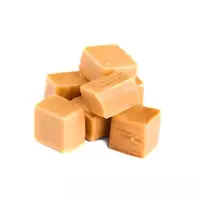Caramel

A well-known treat and confection caramel has been known to people since ancient times. Modern caramel got its name thanks to the French word caramel, which in turn is borrowed from the Latin language. The Latin word Cannamella or sugarcane is at the heart of the name caramel for a reason.
The thing is that the first ancient caramel began to be made in the territory of modern India. In those distant times, Dalits or the people of Ancient India roasted sugar cane trunks directly on an open fire. Natural caramel enjoyed well-deserved popularity.
However, caramel in its modern form appeared much later, when the chefs of the Middle Ages began to experiment with sugar. In medieval Europe, sugar belonged to quite expensive products that only the king and his entourage could afford. Therefore, the first caramel began to be used to decorate royal receptions, balls or feasts.
Caramel composition
The composition of caramel has not undergone significant changes since the Middle Ages. Currently, anyone can make caramel according to old recipes, for this you need only two ingredients - water and sugar. The composition of caramel usually includes sugar or sweet molasses. The caramel is obtained by gradually heating and boiling the sugar-containing aqueous solution.
Types of caramel
The caramel variety depends on several factors, such as the temperature or composition of the starting ingredients. There are the following types of caramel: solid, it is usually made of candy or soft, such sweetness is added to confectionery, and is also used as a food additive. Depending on the content of sugar substances, caramel based on glucose, sucrose or maltose is distinguished.
Such types of caramel as candy, medicinal, vitaminized and others are also poured. Caramel tastes fruity, chocolate, liqueur, berry. Many varieties of confectionery are made on the basis of caramel, so this sweetness is incredibly popular in the culinary traditions of many countries of the world.
Modern master confectioners create true caramel masterpieces. Caramel is used to create excellent handmade sweets and exquisite desserts. sweet paintings. Given the composition of the product, the basis of which is sugar, you should pay attention to the fact that the calorie content of caramel is at a fairly high level. The average calorie content of caramel per 100 grams of product corresponds to 378 Kcal.
This is certainly a lot for a dietary food product and relatively little for sweets or confectionery. For example, the calorie content of 100 grams of popular filled chocolates is 569 Kcal. Therefore, to some extent, caramel can be considered a safer confectionery to preserve the figure. However, do not forget that every product is good and useful if consumed in reasonable quantities.
caramel 378 kCal
Energy value of caramel (Ratio of proteins, fats, carbohydrates - ju):
Proteins: 1 g (~ 4 kCal)
Fats: 0.8 g (~ 7 kCal)
Carbohydrates: 92.9 g (~ 372 kCal)
Energy ratio (bj | y): 1% | 2% | 98%
 Español
Español Français
Français Português
Português Русский
Русский 简体中文
简体中文 繁體中文
繁體中文 日本語
日本語 한국어
한국어 العربية
العربية Türkçe
Türkçe Қазақ
Қазақ Deutsch
Deutsch Italiano
Italiano Українська
Українська
